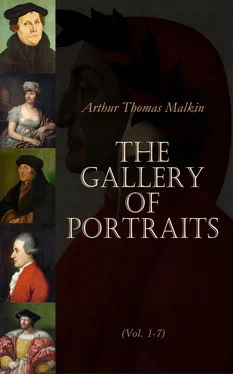The history of Buffon is singularly barren of incident. At an early age he devoted himself to those studies of natural history which have rendered his name so famous; and at eighty years old he was still labouring at the completion of the great plan to which he had dedicated his life.
George Lewis le Clerc Buffon was born at Montbar, in Burgundy, on the 7th September, 1707. His father, Benjamin le Clerc, was a man of fortune, who could afford to bestow the most careful education upon his children, and leave them unfettered in the choice of an occupation. The young Buffon had formed an acquaintance at Dijon with an Englishman of his own age, the Duke of Kingston. The tutor of this nobleman was, fortunately, an accomplished student of the physical sciences; and he gave a powerful impulse to the talents of Buffon, by leading them forward in their natural direction. Without the assistance of this judicious friend, the inclination of his mind towards honourable and useful exertion might have been suppressed by the temptations which too easily beset those who have an ample command of the goods of fortune. It was not so with Buffon. Although he succeeded, at the age of twenty-one, to the estate of his mother, which produced him an annual income of 12,000 l. , he devoted himself with unremitting assiduity to the acquisition of knowledge. Having travelled in Italy, and resided some little time in England, he returned to his own country, to dedicate himself to the constant labours of a man of letters. His first productions were translations of two English works of very different character—‘Hales’ Vegetable Statics,’ and ‘Newton’s Fluxions;’ and, following up the pursuits for which he exhibited his love in these translations, he carried on a series of experiments on the strength of timber, and constructed a burning mirror, in imitation of that of Archimedes.
The devotion to science which Buffon had thus manifested marked him out for an appointment which determined the course of his future life. His friend, Du Fay, who was the Intendant of the ‘ Jardin du Roi ’ (now called the ‘ Jardin des Plantes ’), on his death-bed recommended Buffon as the person best calculated to give a right direction to this establishment for the cultivation of natural history. Buffon seized upon the opportunities which this appointment afforded him of prosecuting his favourite studies, with that energetic perseverance for which he was remarkable. He saw that natural history had to be written in a manner that might render it the most attractive species of knowledge; and that philosophical views, and eloquent descriptions, might supersede the dry nomenclatures, and the loose, contradictory, and too-often fabulous narratives which resulted from the crude labours of ill-informed compilers. To carry forward his favourite object, it was necessary that the museum, over which he had now the control, should be put in order and rendered more complete. He obtained from the government considerable funds for the erection of proper buildings; and the galleries of the ‘ Jardin des Plantes ,’ which now hold the fine collection of mammals and birds, were raised under his superintendence. Possessing, therefore, the most complete means which Europe afforded, he applied himself to the great task of describing the animal, vegetable, and mineral kingdoms of nature. A large portion of this immense undertaking was left unperformed, although, to use his own words, he laboured fifty years at his desk; and much of what he accomplished was greatly diminished in value by his determination to see natural objects only through the clouded medium of his own theories. But, nevertheless, he has produced a work which, with all its faults, is an extraordinary monument of genius and industry, and which will long entitle him to the gratitude of mankind. “We read Buffon,” says Condorcet, “to be interested as well as instructed. He will continue to excite a useful enthusiasm for the natural sciences; and the world will long be indebted to him for the pleasures with which a young mind for the first time looks into nature and the consolations with which a soul weary of the storms of life reposes upon the sight of the immensity of beings peaceably submitted to necessary and eternal laws.”
Buffon was in some particulars unqualified for the laborious duty he had undertaken. He delighted to indulge in broad and general views, and to permit his imagination to luxuriate in striking descriptions. But he had neither the patience, nor the love of accuracy, which would have carried him into those minute details which give to natural history its highest value. He, however, had the merit and the good fortune, in the early stages of his undertaking, to associate himself with a fellow-labourer who possessed those qualities in which he was deficient. The first fifteen volumes of ‘L’Histoire Naturelle,’ which treat of the theory of the earth, the nature of animals, and the history of man and viviparous quadrupeds, were published between 1749 and 1767, as the joint work of Buffon and Daubenton. The general theories, the descriptions of the phenomena of nature, and the pictures of the habits of animals, were by Buffon. Daubenton confined himself to the precise delineation of their physical character, both in their external forms and their anatomy. But Daubenton refused to continue his assistance in the ‘History of Birds;’ for Buffon, unwilling that the fame which he had acquired should be partaken by one whom he considered only as a humble and subordinate labourer, allowed an edition of the History of Quadrupeds to be published, of which the descriptive and anatomical parts had been greatly abridged. In the History of Birds, therefore, Buffon had to seek for other associates; and the form of the work was greatly changed from that of the previous volumes. The particular descriptions are here very meagre, and anatomical details are almost entirely excluded. In some of the volumes, Buffon was assisted by Guéneau de Montbeillard, who, instead of endeavouring to attain the accuracy of Daubenton, affected to imitate the style of his employer. To the three last volumes of the Birds the Abbé Bexon lent his aid. The nine volumes of Birds appeared between 1770 and 1783. Buffon published alone his ‘History of Minerals,’ which appeared in five volumes, between 1783 and 1788. Seven volumes of Supplements complete the Natural History. The first appeared in 1773; the last was not published till the year after its author’s death, in 1789. The fifth volume of these Supplements is a distinct work, the Epochs of Nature [3].
The study of natural history, and the composition of his great work, occupied the mind of Buffon from his first appointment as Intendant of the ‘ Jardin du Roi ,’ to within a few days of his death. In the prosecution of the plan he had laid down, he never permitted the slightest interruption. Pleasure and indolence had their attractions;—but they never held him for many hours from his favourite pursuits. Buffon spent the greater part of his time at Montbar, where, during some years, his friend Daubenton also resided. It was here that Buffon composed nearly the whole of his works. Many interesting details have been preserved of his habits of life, and his mode of composition. He was, like all men who have accomplished great literary undertakings, a severe economist of his time. The employment of every day was fixed with the greatest exactness. He used almost invariably to rise at five o’clock, compelling his man-servant to drag him out of bed whenever he was unwilling to get up. “I owe to poor Joseph,” he used to say, “ten or twelve volumes of my works.” At the end of his garden was a pavilion which served him as a study. Here he was seated for many hours of every day, in an old leathern chair, before a table of black birch, with his papers arranged in a large walnut-tree escritoire. Before he began to write he was accustomed to meditate for a long time upon his subject. Composition was to him a real delight; and he used to declare that he had spent twelve or fourteen hours successively at his desk, continuing to the last in a state of pleasure. His endeavours to obtain the utmost correctness of expression furnished a remarkable proof of the persevering quality of his mind. He composed, and copied, and read his works to friends, and re-copied, till he was entirely satisfied. It is said that he made eleven transcripts of the Epochs of Nature. In his domestic habits there was little to admire in the character of Buffon. His conversation was trifling and licentious, and the grossness which too often discloses itself in his writings was ill-concealed in his own conduct. He paid the most minute attention to dress, and delighted in walking to church to exhibit his finery to his wondering neighbours. Although he was entirely devoid of religious principle, and constantly endeavoured in his writings to throw discredit upon the belief of a great First Cause, he regularly attended high mass, received the communion, and distributed alms to pious beggars. In his whole character there appears a total absence of that simplicity which is the distinguishing attribute of men of the very highest genius.
Читать дальше












